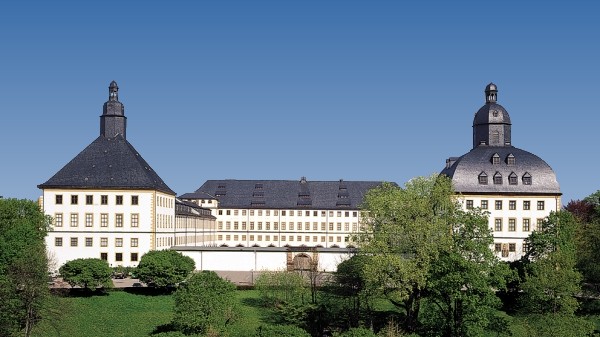Friedenstein Castle rises above the city of Gotha on the site of the former Grimmenstein Castle. The medieval castle was converted into a fortress in the 16th century, which was destroyed in 1567. After the Ernestine division of land in 1640, Gotha became the residential town of the newly created Duchy of Saxony-Gotha. Duke Ernst I, the Pious, laid the foundation stone in 1643 for the palace building planned by Andreas Rudolph, which was given the name Friedenstein, programmatic for the period of the Thirty Years' War. Until 1825, the palace was the residence of the Dukes of Saxe-Gotha and Altenburg and then, along with Coburg, the residence of the Dukes of Saxe-Coburg and Gotha until 1918.

The three-winged complex opens to the south, facing away from the city. The residential area in the north, as well as the pavilions as the end of the side wings in the south, have three upper floors, the side wings two. The facades are almost unadorned, with the exception of a few architectural elements.
Inside, the banqueting hall and reception and living rooms from the second phase of furnishing from 1683 to 1697 under Duke Frederick I are preserved. They were executed under the direction of Giovanni Caroveri. The stuccoworkers Johann Samuel and Johann Peter Rust and the painter Seyfried Lammers were active in the palace church, which was refurnished from 1695-1697. Further living quarters were decorated in the rococo style between 1747 and 1751 according to designs by Gottfried Heinrich Krohne. In the course of the 18th century, new rooms for the ducal family were also built in the east wing. From 1796, the court sculptor Friedrich Wilhelm Eugen Doell was involved in the furnishing of neoclassical living rooms in the west wing. From 1804, Duke August also had his room creations, influenced by his own ideas, realized in this suite of rooms.
Wearing felt slippers, I slog reverently through the castle, take a look at the collections - for example, the Egyptian museum with sarcophagi and mummies - and visit the baroque theater built by Conrad Ekhof in 1775.
The west pavilion of the castle houses the Ekhof Theater, completed in 1683, with its original stage equipment and auditorium rebuilt in the 18th century. It experienced its heyday under Conrad Ekhof between 1775 and 1779 as a German-language stage with its own ensemble.
In the east pavilion, which burned out in 1677, the pillared hall, furnished in 1687, with original library equipment is preserved.
To the east of the palace is the Orangery Garden with an orangery building and a greenhouse on each of the north and south sides, which were built from 1747 onwards. In this garden area the widely praised potted plant stock with up to 3000 plants was presented. After the destruction of the war, the exterior of the buildings has been restored, except for the southern greenhouse. The associated garden area shows the design from the time around 1930.
View from the castle: In front on the right is the monument of Ernst the Pious. Down the castle hill and the square you can see the town hall with the red tower in the background.
View of Gotha from the castle. In the center the Margarethen church.

Further down on the main market is the Lucas Cranach House.
Lucas Cranach the Elder, born in 1472 in Kronach, Upper Franconia; died October 16, 1553 in Weimar, was a German Renaissance painter and graphic
artist.
In 1501, at the age of 29, Cranach went to Vienna and remained there until 1504. In 1505, he appears for the first time in the documents of the city of Wittenberg and was given
a position as court painter to Elector Frederick the Wise of Saxony. Around 1512 Cranach married Barbara Brengebier. She was born here and was a daughter of Jobst Brengebier,
the mayor of Gotha.
more about
Note on the Saxe-Coburg-Gotha family
Through clever marriage policies, several European royal houses descended from the Saxe-Coburg-Gotha dynasty.
-
former Bulgarian and Portuguese kings
-
Belgian kings until today
In Britain, the House of Hanover, a collateral line of the German noble family of Guelph, had ruled since 1714.
Victoria married her maternal cousin Albert of Saxe-Coburg and Gotha in 1840. She thus entered the House of Saxe-Coburg-Gotha, and her children bore that name. Saxe-Coburg-Gotha thus became the name of the new dynasty ruling in Britain. Formally, the house still reigns there today, but during the First World War King George V saw fit to change the all too German-sounding name to House of Windsor. -
In the female line, the House of Saxe-Coburg-Gotha rules in Sweden; the eldest daughter of the last Saxe-Coburg-Gotha Duke Carl Eduard, Princess Sibylla, married Prince Gustav Adolf of Sweden in 1932. Their joint son Carl XVI Gustaf has been King of Sweden since 1973. However, since the name of the ruling dynasty is determined by male, not female, succession, the House of Bernadotte rules Sweden today. Andreas Prince of Saxe-Coburg and Gotha (* 21. March 1943 on castle Casel in the Niederlausitz) is since 1998 Head of the House of Saxe-Coburg and Gotha.
Way of St. James Erfurt - Eisenach